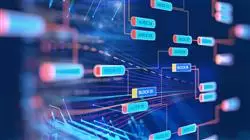University certificate
The world's largest faculty of information technology”
Description
Every day malicious people try to compromise the security of companies and institutions that manage very valuable data: you could be the great protector of that information"

Every day, millions of people perform all kinds of activities on the Internet. They check the news, chat with friends and family, share opinions on social networks, carry out administrative tasks in different companies and institutions, share all kinds of files or do work-related tasks. Therefore, countless amounts of data are being created and transferred all over the world at every moment.
Managing them with adequate security is not a simple task, as it requires a range of specific knowledge from various fields that would not normally be in contact with each other. For that reason, this advanced master’s degree in Secure Information Management is an outstanding opportunity for all those engineers and IT professionals who want to integrate information management and cybersecurity to become top specialists in both areas.
Many companies and institutions handle highly sensitive and valuable data that requires proper administration, preservation and monitoring. There are still not many experts in both disciplines who can take charge and adequately manage all aspects. Therefore, students who complete this advanced master’s degree will be perfectly placed to reach top positions in companies who are seeking to secure their digital information
To this end, TECH has designed the best content and has brought together the best teachers, with extensive professional experience in these areas, so that students receive the most complete education possible and can progress in the workplace.
Everything we do in the digital realm is recorded. Make the Internet a safer place thanks to this advanced master’s degree"
This advanced master’s degree in Secure Information Management contains the most complete and up-to-date educational program on the market. The most important features include:
- The development of case studies presented by computer science experts
- The graphic, schematic, and eminently practical contents with which they are created, provide scientific and practical information on the disciplines that are essential for professional practice
- Practical exercises where self-assessment can be used to improve learning
- Its special emphasis on innovative methodologies in digital data management and security
- Theoretical lessons, questions to the expert, debate forums on controversial topics, and individual reflection assignments
- Content that is accessible from any fixed or portable device with an Internet connection
The best companies in the country will trust you with the management and security of their data when you complete this program"
Its teaching staff includes professionals belonging to the field, who bring the experience of their work to this program, in addition to recognized specialists from prestigious reference societies and universities.
The multimedia content, developed with the latest educational technology, will provide the professional with situated and contextual learning, i.e., a simulated environment that will provide an immersive learning experience designed to train for real-life situations.
This program is designed around Problem-Based Learning, whereby the student must try to solve the different professional practice situations that arise during the academic year. For this purpose, the professional will be assisted by an innovative interactive video system created by renowned and experienced experts.
This advanced master’s degree combines two essential disciplines for the future of your career. Enroll now and achieve all your goals"

Learn all about data management and data security and see how you advance professionally in a very short time"
Objectives
The main objective of this advanced master’s degree in Secure Information Management is to provide students with the best knowledge in two distinct but interrelated branches of computer science and engineering: data management in the digital environment and cybersecurity. By combining these two areas, computer scientists and professionals who take this program will be able to apply the best solutions in every situation that arises in their careers, offering the most appropriate tools to their companies in order to manage and protect all types of sensitive information.

Your goal is to be the best specialist in your company and TECH offers you the tools to achieve it”
General objectives
- Analyze the benefits of the application of data analytics techniques in each department of the company
- Develop the basis for understanding the needs and applications of each department
- Generate specialized knowledge to select the right tools
- Propose techniques and objectives to be as productive as possible according to the department
- Analyze the role of the cybersecurity analyst
- Delve into social engineering and its methods
- Examine OSINT, HUMINT, OWASP, PTEC, OSSTM and OWISAM methodologies
- Conduct a risk analysis and understand risk metrics
- Determine the appropriate use of anonymity and use of networks such as TOR, I2P and Freenet
- Compile current cybersecurity regulations
- Generate specialized knowledge to perform a security audit
- Develop appropriate usage policies
- Examine the most important threat detection and prevention systems
- Evaluate new threat detection systems, as well as their evolution with respect to more traditional solutions
- Analyze the main current mobile platforms, their characteristics and use
- Identify, analyze and assess security risks of the IoT project parts
- Evaluate the information obtained and develop prevention and hackingmechanisms
- Apply reverse engineering to the cybersecurity environment
- Specify the tests to be performed on the developed software
- Collect all existing evidence and data to conduct a forensic report
- Duly submit the forensic report
- Analyze the current and future state of computer security
- Examine the risks of new emerging technologies
- Compile the different technologies in relation to computer security
Specific objectives
Module 1. Data Analytics in the Business Organization
- Develop analytical skills to make quality decisions
- Examine effective marketing and communication campaigns
- Determine the creation of scorecards and KPIs according to the department
- Generate specialized knowledge to develop predictive analytics
- Propose business and loyalty plans based on market research
- Develop the ability to listen to the customer
- Apply statistical, quantitative and technical knowledge in real situations
Module 2. Data Management, Data Manipulation and Data Science Reporting
- Perform data analysis
- Unify diverse data: achieving consistency of information
- Produce relevant, effective information for decision making
- Determine the best practices for data management according to its typology and uses
- Establish data access and reuse policies
- Ensure security and availability: availability, integrity and confidentiality of information
- Examine tools for data management using programming languages
Module 3. IoT Devices and Platforms as a Foundation for Data Science
- Identify what IoT is (Internet of Things) and IIoT (Industrial Internet of Things)
- Examine the Industrial Internet Consortium
- Analyze what is the IoT reference architecture
- Address IoT sensors and devices and their classification
- Identify communications protocols and technologies used in IoT
- Examine the different Cloud platforms in IoT: general purpose, industrial and open source
- Develop data exchange mechanisms
- Establish security requirements and strategies
- Present the different IoT and IIoT application areas
Module 4. Graphical Representation for Data Analysis
- Generate specialized knowledge in data representation and analytics
- Examine the different types of grouped data
- Establish the most commonly used graphical representations in different fields
- Determine the principles of design in data visualization
- Present graphic narrative as a tool
- Analyze the different software tools for graphing and exploratory data analysis
Module 5. Science Data Tools
- Develop skills to convert data into information from which knowledge can be extracted
- Determine the main characteristics of a dataset, its structure, components and the implications of its distribution in modeling
- Support decision making by performing comprehensive data analysis in advance
- Develop skills to solve practical cases using data science techniques
- Establish the most appropriate general tools and methods for modeling each dataset based on the preprocessing performed
- Evaluate results analytically, understanding the impact of the chosen strategy on the different metrics
- Demonstrate critical capacity to the results obtained after applying preprocessing or modeling methods
Module 6. Data Mining Selection, Processing and Transformation
- Generate specialized knowledge about the statistical prerequisites for any data analysis and evaluation
- Develop the necessary skills for data identification, preparation and transformation
- Evaluate the different methodologies presented and identify advantages and disadvantages
- Examine problems in high dimensional data environments
- Develop the implementation of the algorithms used for data preprocessing
- Demonstrate the ability to interpret data visualization for descriptive analysis
- Develop advanced knowledge on the different existing data preparation techniques for data cleaning, normalization and transformation
Module 7. Predictability and Analysis of Stochastic Phenomena
- Analyze time series
- Develop the formulation and basic properties of univariate time series models
- Examine the methodology of modeling and prediction of real time series
- Determine the univariate models including outliers
- Apply dynamic regression models and apply the methodology for the construction of such models from observed series
- Address the spectral analysis of univariate time series, as well as the fundamental aspects related to periodogram-based inference and its interpretation
- Estimate the probability and trend of a time series for a given time horizon
Module 8. Design and Development of Intelligent Systems
- Analyze the transition from information to knowledge
- Develop the different types of machine learning techniques
- Examine metrics and scores to quantify the quality of the models
- Implement the different machine learning algorithms
- Identify probabilistic reasoning models
- Laying the foundation for deep learning
- Demonstrate the skills acquired to understand the different machine learning algorithms
Module 9. Data-intensive Systems and Architectures
- Determine the requirements of mass data usage systems
- Examine different data models and analyzing databases
- Analyze the key functionalities for distributed systems and their importance in different types of systems
- Evaluate which widely used applications use the fundamentals of distributed systems to design their systems
- Analyze the way in which databases store and retrieve information
- Specify the different replication models and the associated problems
- Develop ways of partitioning and distributed transactions
- Determine batch systems and (near) real-time systems
Module 10. Practical Application of Data Science in Business Sectors
- Analyze the state of the art of artificial intelligence (AI) and data analytics
- Develop specialized knowledge of the most widely used technologies
- Generate a better understanding of the technology through use cases
- Analyze the chosen strategies to select the best technologies to implement
- Determine the areas of application
- Examine the actual and potential risks of the applied technology
- Propose benefits derived from the use
- Identify future trends in specific sectors
Module 11. Cyberintelligence and Cybersecurity
- Develop methodologies used in cybersecurity
- Examine the intelligence cycle and establish its application in cyberintelligence
- Determine the role of the intelligence analyst and the obstacles to evacuation activity
- Establish the most common tools for intelligence production
- Conduct a risk analysis and understand the metrics used
- Gain sound knowledge the anonymity options and the use of networks such as TOR, I2P, FreeNet
- Detail the current regulations in cybersecurity
- Specify backup policies for personal and professional data
Module 12. Host Security
- Assess the different tools to provide solutions to specific security problems
- Establish mechanisms to have an updated system
- Scan equipment for intruders
- Determine system access rules
- Screen and classify mails to avoid frauds
- Generate lists of allowed software
- Analyze current network architectures to identify the perimeter to protect
Module 13. Network Security (Perimeter)
- Develop specific firewall and Linux configurations to mitigate the most common attacks
- Compile the most commonly used solutions such as Snort and Suricata, as well as their configuration
- Examine the different additional layers provided by next-generation firewalls and network functionalities in cloud environments
- Determine the tools for network protection and demonstrate why they are fundamental to a multilayer defense
- Examine the different attack vectors to avoid becoming an easy target
Module 14. Smartphone Security
- Determine the main attacks and types of malware to which users of mobile devices are exposed
- Analyze the most current devices to establish greater security in the configuration
- Specify the main steps to perform a penetration test on both iOS and Android platforms
- Develop specialized knowledge about the different protection and security tools
- Establish best practices in mobile device-oriented programming
- Analyze the main IoT architectures
Module 15. IoT Security
- Examine connectivity technologies
- Develop the main application protocols
- Specify the different types of existing devices
- Assess risk levels and known vulnerabilities
- Develop safe use policies
- Establish appropriate conditions of use for these devices
- Examine IOSINT methods
Module 16. Ethical Hacking
- Compile the information available in public media
- Scan networks for active mode information
- Develop testing laboratories
- Analyze the tools for pentesting performance
- Catalog and assess the different vulnerabilities of the systems
- Specify the different hacking methodologies
Module 17. Reverse Engineering
- Analyze the phases of a compiler
- Examine x86 processor architecture and ARM processor architecture
- Determine the different types of analysis
- Apply sandboxing in different environments
- Develop different malware analysis techniques
- Establish malware analysis-oriented tools
Module 18. Secure Development
- Establish the necessary requirements for the correct operation of an application in a secure manner
- Examine log files to understand error messages
- Analyze the different events and decide what to show to the user and what to keep in the logs
- Generate a sanitized, easily verifiable, and quality code
- Evaluate appropriate documentation for each phase of development
- Specify the behavior of the server to optimize the system
- Develop modular, reusable and maintainable code
Module 19. Forensic Analysis
- Identify the different elements that evidence a crime
- Generate specialized knowledge to obtain data from different media before they are lost
- Recovery of intentionally deleted data
- Analyze system logs and records
- Determine how data is duplicated so as not to alter the originals
- Substantiate the evidence for consistency
- Generate a solid and seamless report
- Present conclusions in a coherent manner
- Establish how to defend the report before the competent authority
- Specify strategies for safe teleworking
Module 20. Current and Future Challenges in IT Security
- Examine the use of cryptocurrencies, the impact on the economy and security
- Analyze the situation of users and the degree of digital illiteracy
- Determine the scope of use of blockchain
- Present alternatives to IPv4 in network addressing
- Develop strategies to educate the population in the correct use of technologies
- Generate specialized knowledge to meet new security challenges and prevent identity theft
- Specify strategies for safe teleworking

Cybersecurity and data management are fast-moving disciplines. Take this advanced master’s degree and get the most up-to-date knowledge"
Advanced Master’s Degree in Secure Information Management
Digitalization processes are becoming increasingly common in the different areas in which we develop. However, although these technologies offer multiple benefits for carrying out a large number of work and leisure activities, they can also represent a risk factor for the integrity of users. Faced with a complex scenario in which we are increasingly exposed due to the massive amounts of data that are transferred daily, from conversations through social networks, to sensitive documents hosted on banking or business websites, it is necessary to have professionals who have specialized knowledge in data protection in digital media. For this reason, at TECH Global University we designed the Grand Master in Secure Information Management, a program that will prepare you to collect, process and analyze all types of information, having as a principle of all professional performance, security in data management.
Specialize in secure information management
If you want to stand out as one of the best specialists in a highly competitive sector, this program is perfect for you. The curriculum, presented in a 100% online format, brings together in a comprehensive way the updating, deepening and systematization of the most important aspects on data management and protection, which will allow you to compile the current regulations on cybersecurity, develop appropriate usage policies, evaluate threat detection systems, and identify and develop strategies for risk prevention and resolution. At the largest Faculty of Computer Science you will strengthen your skills and boost your career growth as a cyber intelligence and cybersecurity expert.







